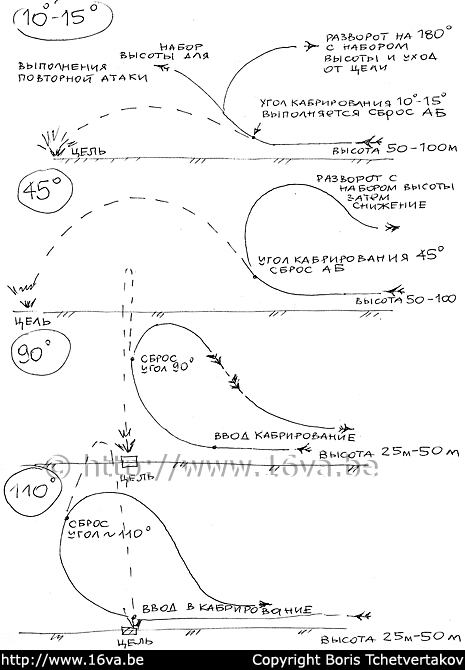

Voici plusieurs techniques de largage de bombes conventionnelles ou nucléaires lors d'une ressource (LABS), telles
qu'appliquées par le 730.APIB (et d'autres unités) au cours des années 80.
D'après B.Tchetvertakov, 730.APIB.
- Largage sous un angle de 10 à 15° après une approche à basse altitude (50-100m).
Le pilote dégageait ensuite par un virage à 180°
en montée ou poursuivait son attaque.
Cette technique était mise en oeuvre par les jeunes pilotes.
- Largage sous un angle de 45° après une approche à basse altitude (50-100m), suivi
d'un Immelmann. Cette technique était bien adaptée aux armes nucléaires, car la
distance moyenne de séparation entre le point de largage et la cible était de
7km.
Le largage de munitions d'entraînement sous cet angle ne pouvait être réalisé en
Allemagne (ni dans les autres pays du pacte de Varsovie) en raison de l'exiguité des
champs de tir.
- Largage sous un angle de 90° après une approche à basse altitude (25-50m), suivi
d'un Immelmann.
- Largage sous un angle de 110° après une approche à basse altitude (25-50m), suivi
d'un Immelmann. Cette technique
était également bien adaptée aux armes nucléaires
non freinées car la bombe mettait 50 à 55 secondes avant de toucher
le sol. Elle
n'était toutefois pas adaptée pour attaquer des batteries Hawk.
Here are some LABS or toss bombing techniques - for conventional and nuclear bombs - as used by the 730.APIB
(and other units) during the eighties. From B.Chetvertakov, 730.APIB.
- Bomb release at an angle of 10-15° after a low level approach (50-100m).
The pilot made a 180° climbing turn after bomb release or pressed on with his attack.
That technique was used by young pilots.
- Bomb release at an angle of 45° after a low level approach (50-100m), followed
by an Immelmann turn. That procedure was well suited for nuclear bombs as the
distance between the release point and the target was on average 7km.
The delivery of training bombs under these conditions could not been done in Germany
(or other Warsaw Pact countries) due to the small size of the firing ranges.
- Bomb release at an angle of 90° after a low level approach (25-50m), followed by
an Immelmann turn.
- Bomb release at an angle of 110° after a low level approach (25-50m), followed
by an Immelmann turn. This procedure was also well suited for free fall nuclear bombs
because the latter took
50 to 55 seconds to reach the ground. It was however not
adapted for attacking Hawk batteries.
